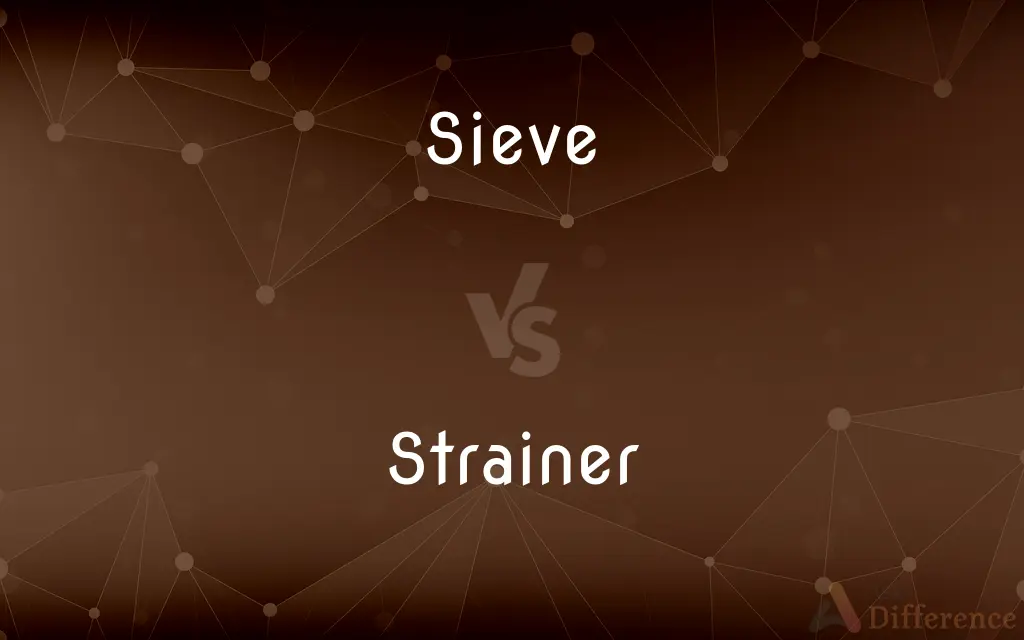Sieve vs. Strainer — What's the Difference?
By Maham Liaqat & Urooj Arif — Updated on April 1, 2024
A sieve usually has a finer mesh for filtering finer particles, while a strainer is often coarser, used for separating solids from liquids.

Difference Between Sieve and Strainer
Table of Contents
ADVERTISEMENT
Key Differences
A sieve is designed to separate fine particles from a mixture, commonly used in baking to aerate flour. On the other hand, a strainer is more robust, typically used to drain water from pasta or wash vegetables, where the particle size is not as critical.
Sieves often come in the form of a mesh made from metal or cloth, making them ideal for filtering finer substances like flour or powdered sugar. Whereas strainers can be made from metal or plastic and have larger holes, suitable for separating larger particles or solids from liquids.
In terms of handling liquids, a sieve is preferred for tasks requiring precision, such as making a smooth sauce or custard by removing lumps. Conversely, a strainer is better suited for quickly separating liquids from solids in foods like boiled vegetables or canned beans without needing fine filtration.
Sieves can also be used in the laboratory setting for particle size analysis, highlighting their ability to filter very fine materials. Strainers, however, are seldom used in such precise applications, emphasizing their role in everyday kitchen tasks rather than in specialized environments.
The construction of sieves often includes a frame that holds the mesh tightly in place, ensuring consistent filtration. Strainers, on the other hand, might have a more open design with a handle and a resting edge, designed for ease of use over pots and bowls.
ADVERTISEMENT
Comparison Chart
Mesh Size
Finer
Coarser
Material
Metal or cloth
Metal or plastic
Primary Use
Separating fine particles
Separating solids from liquids
Application
Baking, sauce making
Draining pasta, washing vegetables
Construction
Frame with tight mesh
Open design with handle
Compare with Definitions
Sieve
A tool in cooking to create smooth textures.
She passed the sauce through a sieve to remove any solids.
Strainer
Often made of metal or plastic with larger holes.
The strainer was perfect for washing the large berries.
Sieve
A device with a mesh used for separating fine particles.
She used a sieve to ensure the flour was lump-free.
Strainer
Can be used for rinsing or draining various foods.
She rinsed the quinoa thoroughly in a fine-mesh strainer.
Sieve
Used in baking to aerate and refine dry ingredients.
He sifted the powdered sugar through a sieve for the frosting.
Strainer
A kitchen utensil used to drain liquids from foods.
He used a strainer to drain the boiled pasta.
Sieve
In laboratories for particle size analysis.
The soil samples were analyzed using different sizes of sieves.
Strainer
Not suited for fine filtration tasks.
A strainer won’t remove coffee grounds from your brew.
Sieve
Symbolic for selecting or separating.
The application process acted as a sieve to find the most suitable candidates.
Strainer
Emphasizes ease of use and versatility.
The strainer's handle made it easy to hold over the sink while draining vegetables.
Sieve
A sieve, fine mesh strainer, or sift, is a device for separating wanted elements from unwanted material or for characterizing the particle size distribution of a sample, using a screen such as a woven mesh or net or perforated sheet material. The word "sift" derives from "sieve".
Strainer
A device having holes punched in it or made of crossed wires for separating solid matter from a liquid
A tea strainer
Sieve
A utensil of wire mesh or closely perforated metal or plastic, used for straining, sifting, ricing, or puréeing.
Strainer
One that strains, as a device used to separate liquids from solids.
Sieve
To pass through a sieve.
Strainer
A standing or fallen tree whose branches are partly submerged in a fast-flowing river, presenting a hazard to navigation or to swimmers.
Sieve
To use a sieve; sift.
Strainer
An apparatus for tightening, stretching, or strengthening.
Sieve
A device with a mesh bottom to separate, in a granular material, larger particles from smaller ones, or to separate solid objects from a liquid.
Use the sieve to get the pasta from the water.
Strainer
A device through which a liquid is passed for purification, filtering or separation from solid matter; anything (including a screen or a cloth) used to strain a liquid.
Sieve
A process, physical or abstract, that arrives at a final result by filtering out unwanted pieces of input from a larger starting set of input.
Given a list of consecutive numbers starting at 1, the Sieve of Eratosthenes algorithm will find all of the prime numbers.
Strainer
A perforated screen or openwork (usually at the end of a suction pipe of a pump), used to prevent solid bodies from mixing in a liquid stream or flowline.
Sieve
(obsolete) A kind of coarse basket.
Strainer
One who strains.
Sieve
(colloquial) A person, or their mind, that cannot remember things or is unable to keep secrets.
Strainer
One who strains.
Sieve
An intern who lets too many non-serious cases into the emergency room.
Strainer
That through which any liquid is passed for purification or to separate it from solid matter; anything, as a screen or a cloth, used to strain a liquid; a device of the character of a sieve or of a filter; specifically, an openwork or perforated screen, as for the end of the suction pipe of a pump, to prevent large solid bodies from entering with a liquid.
Sieve
(category theory) A collection of morphisms in a category whose codomain is a certain fixed object of that category, which collection is closed under precomposition by any morphism in the category.
Strainer
A filter to retain larger pieces while smaller pieces and liquids pass through
Sieve
To strain, sift or sort using a sieve.
Sieve
(sports) To concede; let in
Sieve
A utensil for separating the finer and coarser parts of a pulverized or granulated substance from each other. It consist of a vessel, usually shallow, with the bottom perforated, or made of hair, wire, or the like, woven in meshes.
Sieve
A kind of coarse basket.
Sieve
A strainer for separating lumps from powdered material or grading particles
Sieve
Examine in order to test suitability;
Screen these samples
Screen the job applicants
Sieve
Check and sort carefully;
Sift the information
Sieve
Separate by passing through a sieve or other straining device to separate out coarser elements;
Sift the flour
Sieve
Distinguish and separate out;
Sift through the job candidates
Common Curiosities
Can you use a strainer to sift flour?
While possible, a strainer might not be as effective as a sieve for sifting flour because of its coarser mesh.
Can a sieve be used as a strainer?
Yes, a sieve can sometimes be used as a strainer for finer filtration needs, but it might be less efficient for quickly draining large volumes of liquid.
Is a strainer or sieve better for pasta?
A strainer is generally better for pasta due to its larger holes, allowing for quick drainage of water.
What should I use to rinse quinoa, a sieve or a strainer?
A fine-mesh sieve is preferable for rinsing quinoa, as its small grains may pass through the holes of a coarser strainer.
What is the main difference between a sieve and a strainer?
The main difference lies in their mesh size; sieves have a finer mesh for filtering fine particles, while strainers have coarser meshes for separating solids from liquids.
Can a plastic strainer handle hot liquids?
Plastic strainers can handle hot liquids but are less resistant to heat compared to metal strainers.
Do materials of sieves and strainers affect their use?
Yes, materials can affect durability and suitability for specific tasks, with metal being more durable and suitable for hot ingredients.
How do I choose between a sieve and a strainer?
Consider the task's requirements, such as the size of particles you need to filter or the volume of liquid to drain.
How should I clean a sieve or strainer?
Both should be cleaned immediately after use with warm, soapy water to prevent residue buildup.
Is there a difference in the handle design between sieves and strainers?
Strainers often have handles designed for resting on pots, while sieves might not have handles designed for this purpose.
Are there specialized sieves and strainers for specific tasks?
Yes, there are specialized designs, such as tea strainers or flour sieves, tailored for specific tasks.
Can I use a strainer for tea?
Yes, but finer teas might require a sieve for more effective filtration.
Do sieves come in different mesh sizes?
Yes, sieves come in a range of mesh sizes for different degrees of filtration.
How do I maintain a sieve or strainer?
Regular cleaning and avoiding exposure to extreme conditions will help maintain their condition.
Are sieves used in industries other than food?
Yes, sieves are used in various industries, including pharmaceuticals and construction, for particle size analysis.
Share Your Discovery

Previous Comparison
Price vs. Rates
Next Comparison
Scalar vs. VectorAuthor Spotlight
Written by
Maham LiaqatCo-written by
Urooj ArifUrooj is a skilled content writer at Ask Difference, known for her exceptional ability to simplify complex topics into engaging and informative content. With a passion for research and a flair for clear, concise writing, she consistently delivers articles that resonate with our diverse audience.















































